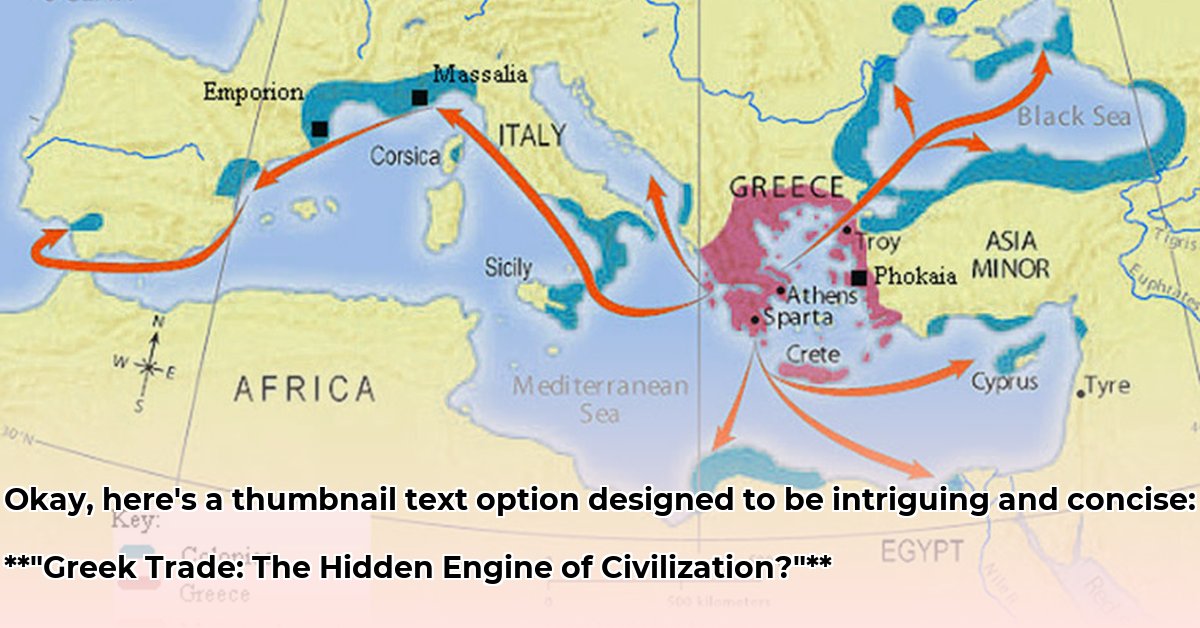Imagine ancient Greece: not merely the cradle of philosophy and architectural marvels, but a vibrant crucible of commerce, where bustling marketplaces and daring maritime ventures defined its very existence. The rugged Greek landscape, notoriously infertile, necessitated a profound reliance on trade. For survival, essential grain poured in from fertile regions like Egypt and the Black Sea. In return, the Greeks expertly exported their renowned produce and craftsmanship, including fine wine, rich olive oil, exquisitely decorated pottery, and durable metal goods. This intricate web of ancient Greek trade was not solely a means to sustain life; it powerfully propelled cultural diffusion, shaping the Hellenic civilization and leaving an indelible mark on the global stage. You can learn more about a typical ancient Greek marketplace.
The Geographical Imperative: Why Greece Traded
The story of trade in ancient Greece is far more than a simple economic transaction; it is a profound testament to survival, innovation, and dynamic cultural exchange, woven deeply into the fabric of their civilization. How did a society, inherently lacking abundant natural resources, ascend to such a commanding position in the ancient world? We delve into the critical aspects that forged their civilization.
Greece confronted a formidable initial challenge: limited arable land. Ancient Greek writers themselves frequently bemoaned their “stingy” and unproductive soil, which was largely unsuitable for extensive agriculture. They famously described their land as if “the gods threw down a pile of rocks.” This inherent geological limitation became a powerful catalyst, compelling them to seek solutions far beyond their geographical boundaries to meet fundamental needs. Foremost among these was grain, whose consistent import from regions like Egypt, famed for its fertile Nile River basin, and the agriculturally rich Black Sea region (especially via Byzantium), became an absolute lifeline for the Greek populace.
One might ponder: could Greece have genuinely attained its legendary status without this pivotal reliance on vital resources from distant lands? The consensus among historians suggests this dependence was fundamentally transformative, enabling urban growth and specialization. Given that most of Ancient Greece was easily accessible by sea, turning to the waters became a natural, inevitable part of their economic evolution. This mastery of the seas allowed them to not only survive but thrive, establishing numerous colonies to support growing trade and foster cultural exchange.
The Pillars of Greek Commerce: What They Traded
In reciprocal exchange for crucial imports, such as life-sustaining grain, the Greeks offered commodities that showcased their distinct skills and celebrated craftsmanship. Their primary exports prominently featured a surprisingly diverse range of goods:
- Wine: A highly coveted beverage enjoyed across the Mediterranean, Greek vineyards, particularly from Aegean islands like Mende and Kos, yielded varieties celebrated for both taste and quality. It was typically transported in amphorae.
- Olive Oil: This versatile product transcended mere culinary use; it was indispensable in cooking, a primary illuminant in lamps, and a key component in skincare and athletic rituals. Like wine, olive oil was a major export carried in amphorae.
- Pottery: Far from simple utilitarian ware, Greek pottery—especially Attic and Corinthian wares—was revered for its intricate beauty and narrative artistry. These vessels, often depicting myths and daily life, adorned homes across the known world. The remarkable discovery of Greek pottery fragments as far away as the Atlantic coast of Africa and Ancient India serves as powerful evidence of the expansive reach of their trade networks.
- Metalwork: Greek artisans demonstrated remarkable mastery in metalworking, skillfully crafting everything from indispensable tools (e.g., knives) and weaponry for warriors to sophisticated decorative objects and bronze craftsmanship.
- Other Specialized Exports: These included emery from Delos (a natural abrasive), hides from Euboea, fine marble from Athens and Naxos (essential for construction and sculpture), and ruddle (a type of waterproofing material for ships) from Keos.
While exporting their crafted goods, the Greek city-states were also significant importers. The goods available at the market places (agorai) of major urban centers, which were imported from outside Greece, included:
- Necessities: Wheat and other grains (crucial for sustenance), slaves (primarily from Egypt), salt fish from the Black Sea, and wood (especially for shipbuilding) from Macedonia and Thrace.
- Raw Materials: Metals such as iron, copper, tin, gold, and silver were vital for coinage and various industries.
- Luxuries: Papyrus (from Egypt, for writing and book production), textiles (from Asia Minor), luxury foods like spices (e.g., pepper, cinnamon, cloves, ginger from India), gemstones (from India), cosmetics (from Egypt), and glass.
This intricate exchange ensured that despite their limited natural resources, the Greeks had access to a rich tapestry of goods, profoundly influencing their daily lives, economy, and culture.
Navigating the Seas: Maritime Mastery and Innovation
The Greeks were not merely merchants; they were accomplished seafarers, unparalleled masters of the marine domain. Their pioneering advancements in maritime technology were absolutely pivotal to their commercial success. Merchant ships underwent continuous improvement, designed specifically for the efficient transportation of substantial goods over impressive distances. Naval technology simultaneously advanced, ensuring the protection of crucial trade routes and deterring persistent pirate threats, which were largely eradicated after 750 BCE.
A significant facilitation for trade from 600 BCE was the construction of specialized merchant ships and the diolkos haulway across the Isthmus of Corinth, allowing ships to be pulled overland, saving a dangerous sea journey around the Peloponnese. The Aegean Sea, dotted with countless islands, naturally became an ideal proving ground for this burgeoning marine prowess. Cities such as Athens and Corinth flourished, evolving into major trading hubs, pulsating with intense activity and cross-cultural exchange.
Consider the port of Piraeus in Athens. From the 5th century BCE, it became the most important trading center in the Mediterranean, functioning as the vibrant, pulsating heart of Mediterranean commerce, a nexus where goods, ideas, and people from across the ancient world converged. Other important permanent trading places (emporia) sprang up, such as Al Mina on the Orontes River (modern Turkey), Ischia-Pithekoussai (off the coast of modern Naples), Naucratis in Egypt, and Gravisca in Etruria. Major Aegean trade hubs also included Ephesus and Rhodes, which acted as centers for the redistribution of goods.
Financing the Ventures: The Nautikos Tokos System
Have you ever considered how did nautikos tokos work? It was far more than a simple financial transaction; it was a fundamental mechanism that fueled an entire civilization! Imagine yourself as a Greek merchant during the 4th century BCE. You possess a sturdy ship, a valuable cargo of olive oil, and the fervent ambition of securing substantial profits in distant, lucrative ports. However, you desperately require upfront capital to finance the extensive voyage. This is precisely where nautikos tokos, or maritime loans, became an indispensable tool. These agreements were, in essence, high-stakes financial bets on the successful completion and profitability of a sea voyage.
These loans functioned as an absolutely critical financial tool, actively enabling merchants to embark on ambitious voyages and thereby facilitating widespread trade across the vast Mediterranean. They were distinctly not your typical bank offerings. Instead, they were inherently risk-laden agreements, meticulously customized for each specific journey and its unique, inherent dangers. This system successfully enabled a high proportion of voyages that would have otherwise been impossible, demonstrating remarkable efficacy in stimulating commerce.
Diving Deep: The Mechanics of Nautikos Tokos
These specialized loans possessed unique and defining features:
- High Interest Rates: The applicable rates could be remarkably substantial, directly reflecting the considerable inherent risks involved in maritime trade. These risks included pervasive piracy, the ever-present threat of shipwrecks, and the unpredictable volatility of ancient markets. Rates historically ranged from 12.5% to 30%, indicating the high risk-reward profile.
- Collateral was the Ship and Cargo: Crucially, the lender’s security was inextricably linked directly to the vessel and its valuable cargo. If the ship was unfortunately lost at sea, the loan was entirely voided, absolving the merchant of repayment. This arrangement signified a true high-stakes gamble for both parties.
- Geographic Specificity: The precise terms and conditions of the loan were frequently restricted to a singular, specified voyage or a defined trade route. In essence, it functioned as a sophisticated combination of voyage insurance and a loan, seamlessly rolled into one comprehensive financial instrument.
- Contractual Customization: Each individual nautikos tokos agreement was meticulously tailored to accommodate the specific needs and unique circumstances of the voyage, encompassing details such as the exact type of goods being transported, the intended destination, and even the prevailing time of year, which influenced weather risks.
The Benefits and Drawbacks: A Balanced View
Like any complex financial instrument, nautikos tokos presented both significant advantages and inherent disadvantages:
| Pros | Cons |
|---|---|
| Access to Capital: Enabled merchants to finance ambitious voyages that would have been otherwise impossible to undertake due to insufficient personal funds, fostering economic dynamism. | High Costs: The substantial interest rates significantly reduced potential profits for successful voyages, making it a costly form of finance. |
| Risk Sharing: Lenders explicitly assumed the considerable risk of maritime disasters, effectively protecting merchants from suffering total financial loss if a catastrophe occurred at sea. | Potential for Abuse: There was inherent potential for unscrupulous lenders to exploit desperate merchants by imposing highly unfavorable and exploitative terms. |
| Stimulated Trade Volume: The provision of accessible capital directly encouraged a greater volume of trade and expanded commercial activity, benefiting the broader Greek economy significantly. | Over-Dependence Risk: Excessive reliance on maritime loans could paradoxically lead to financial instability for merchants, especially during periods of increased maritime peril or economic downturn. |
Decoding the DNA of Ancient Trade
Archaeological discoveries continue to profoundly reshape our understanding of ancient commerce. The meticulous analysis of amphorae, the ubiquitous clay jars specifically designed for transporting goods, has proven particularly revealing. For example, cutting-edge DNA studies have definitively identified traces of various foodstuffs, compellingly challenging the long-held traditional view that ancient Greek trade was almost exclusively dominated by wine and olive oil. We now conclusively know that merchants also extensively transported diverse vegetables, various herbs, and a wide array of nuts. Isn’t it truly astonishing how modern science can unlock such nuanced secrets embedded within the distant past?
The State’s Hand in Trade: Regulation and Protection
The degree of state intervention in regulating trade in ancient Greece was remarkably diverse, often mirroring the unique political philosophies and economic priorities of each individual city-state. The involvement of the state was relatively limited; however, a notable exception was grain. Athens, for instance, a beacon of democratic ideals, meticulously implemented policies designed to guarantee a consistent supply of grain for its populous citizenry. So vital was it to feed Athens’ large population, especially valuable in times of drought, that trade in wheat was controlled and purchased by a special “grain buyer” (sitones). From approximately 470 BCE, the obstruction of the import of grain was prohibited, as was its re-exportation; for offenders, the punishment was the death penalty.
Beyond grain, market officials (agoranomoi) ensured the quality of goods on sale in the marketplaces (agorai) of major urban centers. Grain even had its own supervisors, the sitophylakes, who regulated that prices and quantities were correct. Besides taxes on the movement of goods (e.g., road taxes or, at Chalkedon, a 10% transit charge on Black Sea traffic payable to Athens) and levies on imports and exports at ports, there were also measures taken to protect trade. For instance, Athens taxed citizens who contracted loans on grain cargo that did not deliver to Piraeus or merchants who failed to unload a certain percentage of their cargo.
- Unearth ancient rome achievements: Engineering feats & legal legacies, examined - August 13, 2025
- Unlock ancient rome army ranks: Power, impact & legion command - August 13, 2025
- Conquer Your Exam: Ancient Greece Quiz Ace It Now! - August 13, 2025





![Unveiling Ancient [black people in ancient greece]: New Civilizations Insights, Challenging History black_people_in_ancient_greece_edited](https://www.lolaapp.com/wp-content/uploads/2025/08/black_people_in_ancient_greece_edited-150x150.jpg)










